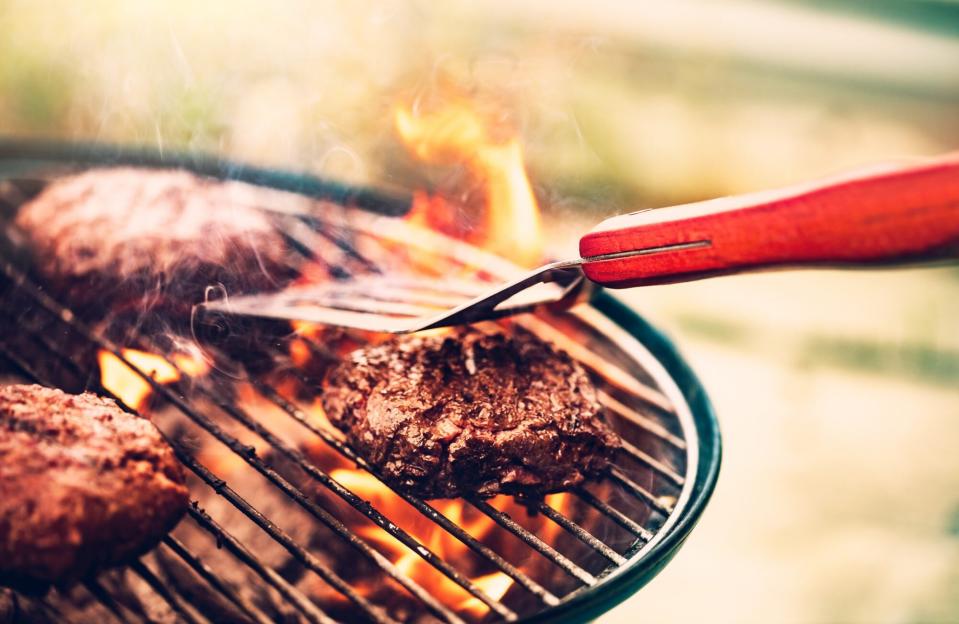How To Pick the Right Charcoal For Your Summer Grilling
When it comes to backyard cookouts, most of us give a great deal of thought to picking out the best grill and grilling recipes, but we often take the charcoal for granted. This is a mistake. According to James Peisker, co-founder of Porter Road, a farm-raised meat company based in Nashville, all charcoal isn't created equal. In fact, he says, "good ingredients make for good meals, and that includes your charcoal." We talked to the experts to get the information you need to choose the right charcoal for your grill along with a few tips to make sure your next cookout is a hit.
Choosing the right charcoal
Chris Lilly is a world championship pitmaster and spokesperson for Kingsford. He's also a partner at the legendary Big Bob Gibson Bar-B-Q, in Decatur, Alabama. In other words, he knows a thing or two about charcoal. We asked him to walk us through what we need to know to choose the right charcoal for our grill.
Pressed briquettes
According to Lilly, pressed briquettes take the prize when it comes to versatility. He says, "this charcoal type is what most people think of when you mention charcoal. Because briquettes are compressed, the result is a much longer burn when compared to other charcoal types. The exact briquette sizing means consistent airflow, resulting in steady cooking temperatures."
Lilly says pressed briquettes are an excellent fit for both beginners and advanced level pitmasters and they work equally well for direct grilling and low and slow barbecuing.
Instant briquettes
Lilly says Instant briquettes are the perfect fit for grillers who want charcoal flavor with fewer steps. He adds, " This light it and go method offers briquette long burn consistency, with instant light capability." He also adds that if you want to achieve the best possible flavor with instant briquettes, it's important to wait for the charcoal to ash over prior to cooking.
Lump charcoal
Lilly says, "lump charcoal are pieces of hardwood that have been turned to carbon. With lump charcoal, you can count on a fast lighting, hot burning charcoal that leaves only a small amount of ash after the burn." Lily also cautions that because lump charcoal is not as dense as briquettes, the burn time is much less. He also says that because it is the size and shape of wood sticks and chips, the temperature can vary due to inconsistent airflow.
Binchotan
Binchotan is less common than the other types of charcoal. According to Lilly, "this charcoal type lights fast and burns extremely hot. Because of the exact sizing and high density of the carbon wood, the result is an even burn with a consistent long-burning temperature. He says the drawback is the fact that binchotan is very expensive and often hard to find. He adds, "so much so, you might opt for spending the extra money on better quality meat instead of this pricey charcoal."

Getty Images
Tips for grilling with charcoal
Now that you've got a guide to help you pick the right charcoal, Peisker has a few tips to make sure your food comes out as delicious as can be.
Peisker avoids using lighter fluid since it can add a chemical flavor to your food. He suggests using a chimney instead. He also says, "It's always great to have two heat zones, especially when grilling things like fresh sausage. Start over low heat to slowly bring up the temperature, and allow the casings to expand, before finishing over high heat. Conversely, if you've already seared a thick steak and realized the internal temperature isn't where you'd like it, you can move it over to the low heat zone to continue cooking."
Lastly, he says, "No matter what, you want to have one really hot spot. A little char is your friend; it's why you're grilling after all! Finish your steaks, chops, sausage with a little char to get that Maillard reaction that will give so much flavor."

